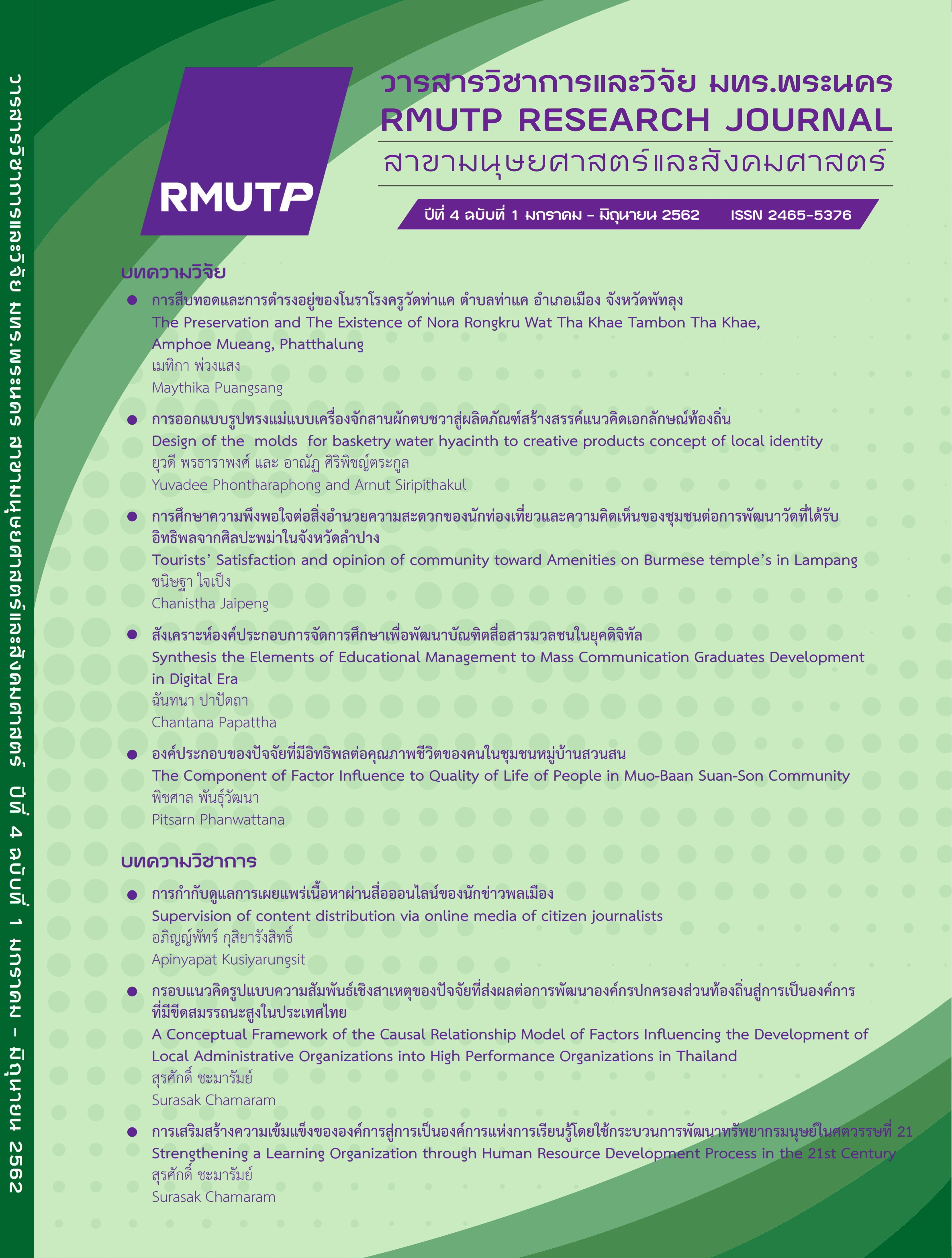The Component of Factor Influence to Quality of Life of People in Muo-Baan Suan – Son Community none
Main Article Content
Abstract
The objective of this research were to study 1) General features of economic factor, social factor, environment factor and personal factor of people in muo-baan Suan-Son community and 2) The influence of economic factor, social factor, environment factor and personal factor involvement on quality of life of people in muo-baan Suan-Son community. This study was conducted by applying 2 research methodologies. For quantitative approach, questionnaires were used to collect data 216 from people in muo-baan Suan-Son community. The data was analyzed by using descriptive statistics and hierarchical regression analysis. With the qualitative approach, in-depth interview, group discussion, structured observation and field notes. The results indicated that 1) Most of people in muo-baan Suan-Son community had low bachelor degree, enough income each month, satisfied with family over work and community, considered that the environmental protection in the community was moderate and the environment in the community was middle clean and enough. 2) The component of factor influence to quality of life of people in Muo-Baan Suan–Son community had health, treat, family, community and welfair.
Article Details
References
ศิรินันท์ กิตติสุขสถิต เฉลิมพล แจ่มจันทร์ กาญจนา ตั้งชลทิพย์ และจรัมพร โห้ลำยอง. (2557). คุณภาพชีวิต การทำงาน และความสุข: โครงการจับตาสถานการณ์ความสุขของคนทํางานในประเทศไทย สถาบันวิจัยประชากรและสังคม มหาวิทยาลัยมหิดล. นนทบุรี: อัพทรูยู ครีเอทนิว.
สถาบันวิจัยประชากรและสังคม มหาวิทยาลัยมหิดล. (2554). ภาพและชีวิตครอบครัวในสังคมไทย. นครปฐม: โรงพิมพ์เดือนตุลา.
สถาบันพัฒนาองค์กรชุมชน กระทรวงการพัฒนาสังคมและความมั่นคงของมนุษย์. (2559). “ระบบสวัสดิการชุมชน”รากฐานสู่สวัสดิ การสังคมไทยอย่างยั่งยืน. กรุงเทพฯ: สถาบันพัฒนาองค์กรชุมชน (องค์การมหาชน).
สุชาติ ประสิทธิ์รัฐสินธุ์. (2555). ระเบียบวิธีวิจัยทางสังคมศาสตร์. (พิมพ์ครั้งที่ 15). กรุงเทพฯ: สามลดา.
สุชาติ ประสิทธิ์รัฐสินธุ์. (2554). วิธีวิทยาการวิจัยเชิงคุณภาพยุคใหม่. กรุงเทพฯ: สามลดา.
สำนักงานเขตบางกะปิ. (2561). ข้อมูลที่ตั้งหน่วยงานในพื้นที่เขต: ชุมชน. สืบค้นวันที่ 22 พฤษภาคม 2561, จาก http://www.bangk ok.go.th/bangkapi/page/sub/205/ชุมชน
สำนักงานราชบัณฑิตยสภา. (2557). พจนานุกรมฉบับราชบัณฑิตยสภาพ.ศ.2554 (พิมพ์ครั้งที่ 2). กรุงเทพฯ: สำนักงานราชบัณฑิตยสภา.
สำนักงานมาตรฐานการวิจัยในคน สำนักงานคณะกรรมการวิจัยแห่งชาติ. (2561). การวิจัยและหลักจริยธรรมการวิจัยในมนุษย์. สืบ ค้นวันที่ 22 พฤษภาคม 2561, จาก www.ohrs.nrct.go.th/lms/uplo ad/course1/l esson2/lessonpdf/Chapter2 _Basic %20principle.pdf
Bartels, M. (2015). Genetics of Wellbeing and Its Components Satisfaction with Life, Happiness, and Quality of Life: A Review and Meta-analysis of Heritability Studies. Behavior Genetics, 45, 137–156.
Berry, C.M. (2015). Differential Validity and Differential Prediction of Cognitive Ability Tests: Understanding Test Bias in the Employment Context. Annual Review of Organizational Psychology and Organizational Behavior, 2, 435-463.
Creswell, J.W. (2014). Research and Design: Qualitative, Quantitative and Mixed Methods Approaches. 4th ed. New Delhi: Thousand Oaks Press.
Diener, E., & Suh, E. (1997). Measuring Quality of Life: Economic, Social and Subjective Indicators. Social Indicators Research, 40, 189–216.
Duckworth, A.L., & Kern, M.L. (2012). A Meta-Analysis of the Convergent Validity of Self-Control Measures. Journal of Research in Personality, 45(3), 259-268.
Hecimovich, M.D., & Hebert, J.J. (2016). Reliability and Concurrent Validity of an Alternative Method of Lateral Lumbar Range of Motion in Athletes. South African Journal of Sports Medicine, 28(1), 23-26.
Juczynski, Z. (2006). Health-Related Quality of Life: Theory and Measurement. Retrieved May 19, 2018, from file:///C:/Users/ACER/Downloads/F1_10.pdf
Landsheer, J.A., & Boeije, H.R. (2010). In Search of Content Validity: Facet Analysis as a Qualitative Method to Improve Questionnaire Design: An Application in Health Research. Quality and Quantity, 44(1), 59-69.
Liu, L., Li, C., Zhu, D. (2012). A New Approach to Testing Nomological Validity and Its Application to a Second-Order Measurement Model of Trust. Journal of the Association for Information Systems, 13(12), 950-975.
OECD. (2015). OECD Factbook 2015-2016 economic, environmental and social statistics. OECD Publishing: Paris.
Palinkas, L.A., Horwitz, S.M., Green, C.A., Wisdom, J.P., Duan, N., & Hoagwood, K. (2015). Purposeful Sampling for Qualitative Data Collection and Analysis in Mixed Method Implementation Research. Administration and Policy in Mental Health and Mental Health, 42(5), 533–544.
Rogers, K.D., Pilling, M., Davies, L., Belk, R., Green, C.N., & Young, A. (2016). Translation, Validity & Reliability of The British Sign Language (BSL) Version of The EQ-5D-5L. Quality of Life Research, 25, 1825-1834.
Rojas, S.L., & Widiger, T.A. (2013). Convergent and Discriminant Validity of The Five Factor Form. Assessment, 21(2), 143-157.
Ryu, E. (2013). Factorial Invariance in Multilevel Confirmatory Factor Analysis. British Journal of Mathematical and Statistical Psychology, 67(1), 172-194.
Sartori, R. (2010). Face Validity in Personality Tests: Psychometric Instruments and Projective Techniques in Comparison. Quality & Quantity, 44(4), 749-759.
Theofilou, P. (2013). Quality of Life: Definition and Measurement. Europe's Journal of Psychology, 9(1), 150–162.
Wood, M., Paulus, T., Atkins, D.P., & Mackin, R. (2015). Advancing Qualitative Research Using Qualitative Data Analysis Software (QDAS)? Reviewing Potential Versus Practice in Published Studies Using ATLAS.ti and NVivo, 1994–2013. Social Science Computer Review, 34(5), 597-617.
World Health Organization. (2013). Oral Health Surveys: Basic Methods 5th ed. Retrieved May 21, 2018, from http://www.icd.org/content/publications/WHO-Oral-Health-Surveys-Methods-5th-Edition-201 3.pdf
Worms, J., & Touati, S. (2016). Parametric and Non-Parametric Statistics for Program Performance Analysis and Comparison. Retrieved May 21, 2018, from https://hal.inria.fr/hal-01112/fil e/RR-8 875.pdf
Yong, A.G., & Pearce, S. (2013). A Beginner’s Guide to Factor Analysis: Focusing on Exploratory Factor Analysis. Tutorials in Quantitative Methods for Psychology, 9(2), 79-94.


